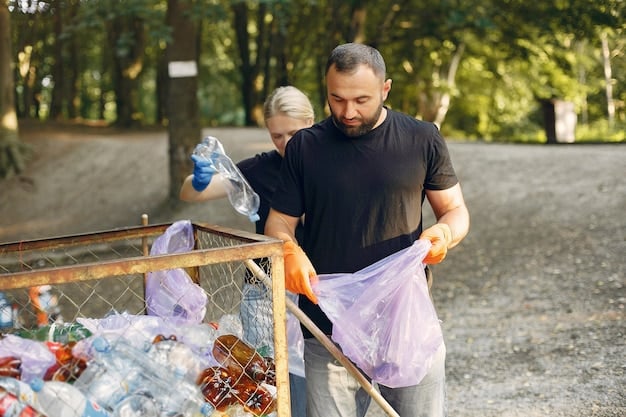Volunteer vacations: combining beach time with giving back on a budget in the US

Volunteer vacations offer a unique opportunity to combine relaxing beach time with meaningful community service, allowing travelers to give back while exploring stunning coastal destinations across the US on a budget, fostering impactful and affordable experiences.
Are you dreaming of sandy toes and ocean breezes, but also seeking a trip that offers more than just relaxation? Consider a volunteer vacation. These unique getaways, particularly volunteer vacations: combine beach time with giving back on a budget in the US, offer an unparalleled opportunity to explore America’s breathtaking coastlines while making a tangible difference. Imagine spending your mornings contributing to vital conservation efforts or community projects, then unwinding on a beautiful beach in the afternoon, all without breaking the bank. This approach to travel not only enriches your experience but also leaves a positive footprint on the places you visit.
The growing appeal of volunteer vacations
The concept of vacationing has evolved significantly over the past few decades. While traditional tourism still holds its charm, an increasing number of travelers are seeking experiences that offer a deeper sense of purpose and connection. This shift has given rise to the popularity of volunteer vacations, often referred to as “voluntourism.” It’s a blend of leisure and service, allowing individuals and families to immerse themselves in new environments while contributing to local communities or environmental causes. The appeal is multifaceted, stemming from a desire for authenticity, personal growth, and a more sustainable way to travel.
For many, a volunteer vacation isn’t just about escaping the daily grind; it’s about finding meaning and making an impact. The opportunity to learn new skills, meet like-minded people, and witness the direct results of one’s efforts can be profoundly rewarding. Moreover, these trips often provide a more intimate and authentic cultural experience than traditional tourist itineraries, fostering a deeper understanding and appreciation for the places visited. The notion of giving back while receiving an unforgettable experience has become a powerful motivator for modern travelers.
Beyond the typical getaway: why voluntourism thrives
Voluntourism is thriving because it addresses several contemporary desires: the need for genuine connection, personal development, and responsible travel. Unlike standard holidays that might leave you feeling disconnected from the local reality, volunteer trips actively integrate you into the fabric of a community or environment. This immersion can lead to powerful revelations and a broadened perspective on global issues. Participants often return home not only refreshed but also with a renewed sense of purpose and a deeper global awareness.
- Meaningful engagement: Move beyond fleeting tourist interactions to genuine connections with locals and causes.
- Skill development: Learn new practical skills, from conservation techniques to community organizing.
- Personal growth: Challenge yourself, step out of your comfort zone, and experience profound self-discovery.
Furthermore, the structure of volunteer vacations often encourages a simpler, more budget-conscious approach to travel. Many programs include accommodations and meals, significantly reducing overall costs compared to conventional trips. This financial accessibility makes meaningful travel attainable for a broader audience, demonstrating that giving back doesn’t have to be a luxury reserved for the few. This blend of purpose, personal growth, and affordability firmly positions voluntourism as an increasingly attractive option for travelers worldwide.
Budget-friendly coastal destinations in the US
When considering a volunteer vacation that combines beach time with giving back on a budget, the United States offers a wealth of diverse coastal destinations. From the rugged shores of the Pacific Northwest to the sunny beaches of Florida and the historic coasts of New England, each region presents unique opportunities for service and relaxation. The key to staying within budget often lies in choosing less frequented spots, opting for off-season travel, and researching organizations that provide affordable or even free volunteer programs.
For example, the Gulf Coast states, including parts of Alabama, Mississippi, and Texas, often present more budget-friendly options compared to the more popular east and west coast hotspots. These areas may offer programs focused on wetland restoration, coastal cleanup, or wildlife rehabilitation, providing vital services in beautiful, yet accessible, settings. Similarly, certain areas of the Carolinas or the Great Lakes region (yes, they have “beaches” too!) can offer unique freshwater coastal volunteering without the premium price tag of oceanfront property.
Hidden gems for affordable coastal volunteering
Beyond the well-trodden paths, there are numerous coastal “hidden gems” perfect for budget-conscious volunteer travelers. These locations might lack the glitz of major tourist hubs but compensate with raw natural beauty, genuine local hospitality, and lower costs. Think of coastal towns in Oregon, parts of rural Maine, or even specific island communities that welcome external support for their conservation or community projects.
Often, organizations working in these less-commercialized areas are more likely to offer programs where the cost of participation is minimal, or sometimes even covered by grants, especially if you have specialized skills they need (though many programs require no prior experience). Researching local non-profits, state park services, and small environmental groups can unearth truly unique and affordable opportunities. Flexibility with your travel dates, avoiding peak season, can further amplify your savings, making these destinations even more attractive for a purposeful and economical beach escape.
Types of beach-focused volunteer opportunities
The range of volunteer opportunities available along US coastlines is as vast and varied as the shorelines themselves. From ecological conservation to community support, there’s a cause for almost every interest, providing an opportunity to contribute while enjoying the serene beauty of the beach environment. These roles often require varying levels of physical activity but generally emphasize passion and a willingness to learn, making them accessible to a wide audience.
One of the most common and impactful types of beach-focused volunteering involves environmental conservation. This can include beach cleanups, where volunteers collect litter and debris to protect marine life and preserve natural habitats. Other ecological tasks might involve dune restoration, planting native vegetation to prevent erosion, or monitoring wildlife, such as sea turtle nesting sites. These activities directly contribute to the health and sustainability of coastal ecosystems, ensuring their beauty for future generations.
Making a splash: popular volunteer roles
Beyond direct environmental work, many coastal communities benefit from volunteers in other capacities. For instance, some programs focus on marine research, where volunteers might assist scientists with data collection or observe marine species. Others involve community outreach, educating locals and tourists about responsible environmental practices or participating in local festivals and events that aim to raise awareness for coastal protection.
- Marine debris removal: Participates in organized beach and underwater cleanups, collecting plastics and other pollutants.
- Wildlife monitoring and protection: Assists in tracking and protecting endangered species, like sea turtles or shorebirds, during their nesting seasons.
- Coastal habitat restoration: Helps plant native species, stabilize dunes, and restore damaged ecosystems.
Additionally, some opportunities may involve supporting local non-profits that provide services to coastal communities, such as food banks, educational programs for children, or disaster relief efforts in areas prone to hurricanes or coastal erosion. These diverse roles ensure that volunteers can find a meaningful way to contribute, aligning their skills and interests with the specific needs of the coastal areas they visit. The versatility of these roles allows for a truly personalized and impactful volunteer vacation experience.

Finding the right volunteer program for you
Identifying the ideal volunteer program requires careful consideration of your interests, skills, time commitment, and budget. With a multitude of organizations offering varied opportunities across the US, it’s essential to research thoroughly to ensure the program aligns with your expectations and helps you achieve your goals for a meaningful and affordable volunteer vacation. Start by defining what kind of impact you want to make and what type of environment you wish to experience.
Begin your search by looking at reputable organizations specializing in voluntourism or environmental conservation. Many non-profits, national parks, and wildlife sanctuaries regularly recruit volunteers for short-term projects that fit perfectly into a vacation schedule. Websites dedicated to volunteer travel, as well as specific state tourism boards or environmental agencies, can be excellent resources. Pay close attention to the program’s mission, its past impact, and testimonials from previous volunteers to gauge its effectiveness and reputation.
Key factors to consider for a fulfilling experience
Beyond the mission, several practical aspects warrant scrutiny. Understand the financial implications: are accommodations and meals included? Is there a program fee, and what does it cover? Some programs are entirely free, especially for longer commitments or specific skilled roles, while others require a fee to cover operational costs or contribute to the project’s funding. Always clarify these details upfront to avoid hidden expenses.
- Program costs: Confirm whether the program fee covers accommodation, meals, and local transportation.
- Duration and commitment: Ensure the project length fits your schedule, from weekend endeavors to multi-week stays.
- Skills required: Check if specific expertise is needed, or if keenness to learn is sufficient.
- Impact and transparency: Research the organization’s track record and how they measure project success.
Furthermore, consider the physical demands of the work, the living conditions, and the amount of free time you’ll have to enjoy the beach or local attractions. A clear understanding of these elements will help you choose a program that not only allows you to give back effectively but also ensures you have a fulfilling and enjoyable vacation experience. Tailoring your selection to these personal and practical considerations is crucial for a truly rewarding volunteer journey.
Planning and preparing for your volunteer vacation
Once you’ve identified a promising volunteer program, meticulous planning and preparation become paramount to ensure a smooth and enjoyable trip. This process extends beyond simply booking flights and packing a suitcase; it involves anticipating the specific needs of your volunteer role, understanding local conditions, and making arrangements to maximize both your service and leisure time. A well-prepared volunteer is a more effective and happier contributor.
Begin by securing your spot in the chosen program well in advance, as popular initiatives can fill up quickly. Follow all registration instructions carefully, and inquire about any pre-departure training or materials they might provide. Think about the specific items your volunteer work might require, whether it’s durable work gloves for beach cleanups, appropriate footwear for nature trails, or insect repellent for coastal marsh areas. Don’t underestimate the importance of reliable sun protection given the often-sunny beach environments.
Essential tips for a seamless and impactful trip
Beyond the immediate volunteer needs, consider the broader travel logistics. Research transportation options to and from your volunteer site, especially if it’s in a remote coastal area. Look into local public transport, ride-sharing, or carpooling with other volunteers. Budget for personal expenses that aren’t covered by the program, such as souvenir shopping, excursions during free time, or dining out on days off. Having a clear financial plan will help maintain the “budget” aspect of your volunteer vacation.
- Packing smart: Prioritize practical work clothing, sun protection, and eco-friendly toiletries.
- Health and safety: Consult your doctor about necessary vaccinations and pack a basic first-aid kit.
- Local research: Learn about the local culture, climate, and community to prepare effectively.
Finally, embrace a flexible and open mindset. Volunteer work can sometimes be unpredictable, and living conditions may differ from what you’re accustomed to. A positive attitude and willingness to adapt will greatly enhance your experience, allowing you to fully immerse yourself in the service and appreciate the unique blend of contribution and coastal relaxation that a volunteer vacation offers. Preparedness not only ensures your comfort but also amplifies the positive impact you’ll make.

Maximizing your experience: giving back and enjoying the beach
The true essence of a volunteer vacation lies in balancing the rewarding efforts of service with the rejuvenation that only a beach environment can provide. To truly maximize your experience, it’s crucial to approach the trip with intentionality, ensuring that both aspects—giving back and enjoying leisure—are fully realized. This balance not only optimizes your personal well-being but also enhances the overall impact of your volunteer work by preventing burnout and fostering a sustainable love for service.
During your volunteer shifts, immerse yourself fully in the tasks at hand. Engage with your fellow volunteers and project leaders, learn as much as you can about the local environment or community issues, and be proactive in your contributions. The deeper your engagement with the service aspect, the more fulfilling it will feel, creating lasting memories and a sense of genuine accomplishment. Remember that your time and effort are valuable, and every contribution, no matter how small, adds up to a significant impact.
Striking the perfect balance between purpose and pleasure
When your volunteer duties conclude for the day or week, shift gears completely to embrace the “vacation” part of your journey. This is your opportunity to explore the local area, relax on the sand, or simply disconnect. Whether it’s snorkeling in clear waters, reading a book under a palm tree, visiting a local seafood shack, or watching a sunset over the ocean, allowing yourself to fully enjoy these moments is vital for recharging and appreciating the beauty of your surroundings.
- Embrace the duality: Dedicate specific times to volunteering and specific times to leisure to maintain balance.
- Connect locally: Spend time with local people, sample local cuisine, and explore the natural beauty of the area.
- Reflect and rejuvenate: Use downtime to process your experiences and appreciate the unique journey you’re on.
Many programs are structured to offer free afternoons or weekends, providing ample opportunity for exploration. Take advantage of this time to discover nearby attractions, participate in water sports, or simply relax. This dual approach ensures that you return home not only with the satisfaction of having made a difference but also with the refreshed spirit and cherished memories of a truly unique and enriching coastal getaway. It’s about letting the purpose of giving back fuel your enjoyment of the beautiful beaches, and vice versa.
| Key Point | Brief Description |
|---|---|
| 🌎 Budget Focus | Find affordable US coastal destinations and programs covering lodging/meals. |
| 🌊 Service Variety | Opportunities range from beach cleanups to marine life protection. |
| 🔍 Program Selection | Research reputable organizations and clarify costs and commitment. |
| 💡 Maximize Impact | Balance dedicated work with ample leisure time to enjoy the beach. |
Frequently asked questions
▼
Common roles include beach cleanups, marine debris removal, sea turtle nesting site monitoring, dune restoration, and planting native coastal vegetation. Some programs also involve wildlife rehabilitation, data collection for marine research, or community outreach focused on environmental awareness. Opportunities vary by location and organization, but most focus on conservation.
▼
To find budget-friendly programs, focus on less-traveled coastal areas or consider off-peak seasons. Look for organizations that cover accommodation and meals, or offer programs without significant fees. Many non-profits and state park services rely on volunteers and may provide free or very low-cost options depending on commitment levels and skills.
▼
Generally, no prior experience is required for most beach-focused volunteer vacations. Organizations typically provide all necessary training and equipment on-site. What’s most valued is a willingness to learn, a positive attitude, and a commitment to the cause. Some specialized roles might require specific skills, but these are usually clearly stated.
▼
Pack practical items like durable work clothes, sturdy closed-toe shoes or boots, and plenty of sun protection (hat, sunglasses, reef-safe sunscreen). Bring a reusable water bottle, insect repellent, and eco-friendly toiletries. Don’t forget swimwear, beach towels, and comfortable casual clothes for your leisure time, ensuring a good balance.
▼
The amount of free time varies significantly by program. Many volunteer vacations are structured to allow afternoons or evenings free, and often weekends are entirely off. This provides ample opportunity to relax on the beach, explore local attractions, or engage in recreational activities. Always check the program’s itinerary for details on a typical day.
Conclusion
Volunteer vacations offer a compelling and enriching alternative to traditional getaways, particularly when seeking to combine the allure of US beaches with the profound satisfaction of giving back. By carefully selecting budget-friendly destinations and programs, travelers can embark on meaningful journeys that not only protect and preserve our precious coastlines but also foster personal growth and cultural immersion. These trips demonstrate that it is possible to enjoy a fulfilling vacation without extensive financial outlay, proving that responsible tourism can be both impactful and accessible. Embrace the opportunity to cleanse both the environment and your spirit, returning home refreshed, enlightened, and with a lasting sense of accomplishment, having contributed to something greater than yourself.





